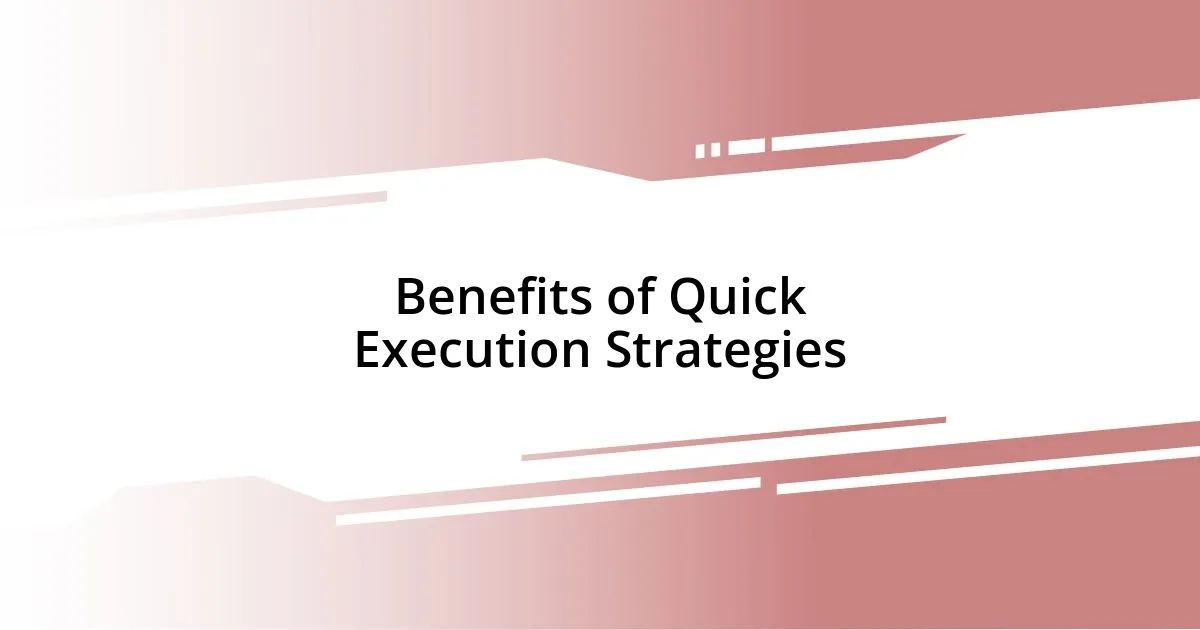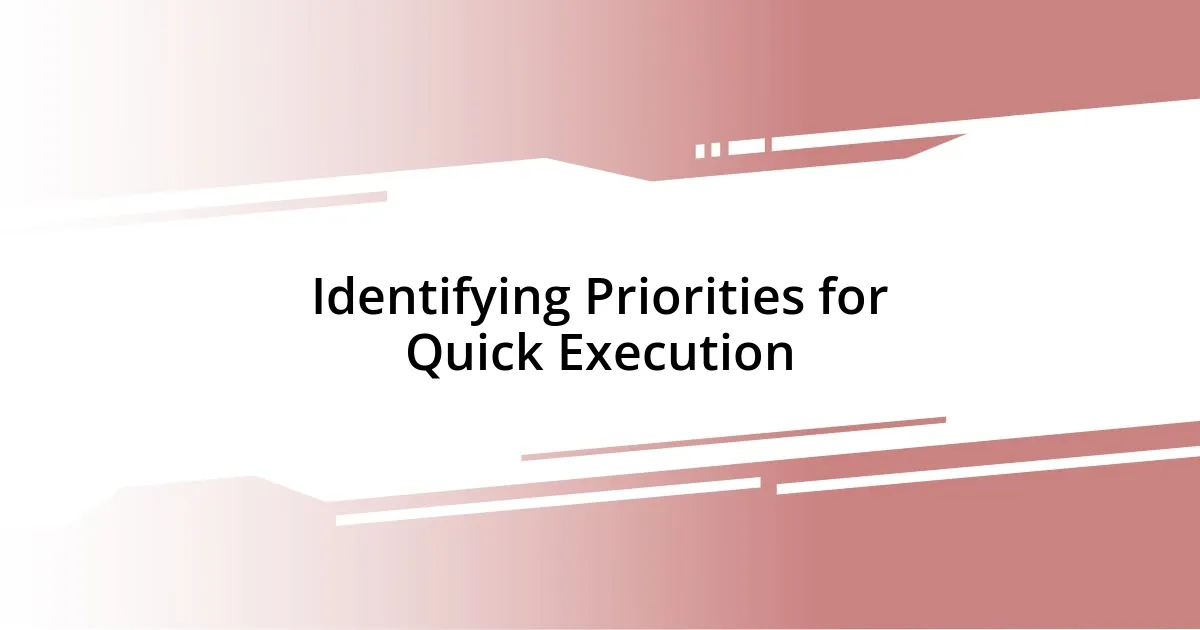Key takeaways:
- Quick execution involves decisiveness and efficiency, allowing teams to adapt and foster creativity.
- Prioritizing tasks and involving team members enhances clarity and collective ownership, driving successful execution.
- Implementing structured time management techniques, like the Pomodoro Technique and time blocking, boosts productivity and focus.
- Measuring success encompasses both outcomes and processes, including stakeholder satisfaction and lessons learned from each project.

Understanding Quick Execution
Quick execution isn’t just about speed; it’s about decisiveness and efficiency. There have been times in my projects when I hesitated, weighing options endlessly, only to realize that action was the crucial missing piece. How many opportunities have you lost simply because you waited too long?
When I think about quick execution, I often remember a team project where we had a tight deadline. I rallied everyone to brainstorm solutions, deciding we had to trust our instincts rather than overanalyze, and it worked! The relief of seeing our ideas come to life so rapidly was exhilarating, a reminder that sometimes, taking the plunge leads to unexpected success.
To me, understanding quick execution means balancing instinct with informed choices. It’s recognizing that perfection can be an enemy to progress. Isn’t it liberating to think that some of the best results come from simply moving forward, even if every detail isn’t perfectly aligned? Each step taken can refine the process, transforming initial efforts into more profound, impactful outcomes.

Benefits of Quick Execution Strategies
When I embrace quick execution strategies, the benefits become crystal clear. I’ve noticed that faster decision-making cultivates a sense of momentum within a team, sparking creativity and enthusiasm. In one instance, we launched a product in record time. The energy and excitement during that period were palpable, as each team member felt empowered to contribute without the fear of getting it “perfect.”
The advantages of quick execution strategies include:
- Enhanced Agility: Teams can adapt promptly to new information or market changes, which is crucial in today’s fast-paced environment.
- Increased Productivity: Working with a proactive mindset minimizes procrastination, enabling continuous progress.
- Heightened Morale: Seeing swift results boosts confidence and motivation, fostering a positive team atmosphere.
- Improved Learning: Rapid execution allows for quicker feedback cycles, facilitating ongoing learning and adjustments that drive future success.
From my experience, the thrill of moving quickly often outweighs the burden of meticulously perfecting every detail. It reminds me that every small success can lead to larger breakthroughs, propelling projects and ideas forward in ways I never imagined.

Identifying Priorities for Quick Execution
When it comes to identifying priorities for quick execution, I often find that clarity is key. During a recent project, I learned the hard way that trying to juggle multiple tasks without a clear order can lead to overwhelming chaos. I made a list of what absolutely needed my attention first, and focusing on those priorities cleared the mental fog. Trust me, the relief of having a clear path is invaluable!
Additionally, I realized how important it is to continuously reassess priorities as the task progresses. For example, while collaborating on a marketing campaign, we thought our initial target audience was spot on, but after some early feedback, we pivoted quickly. It was a game-changer! Understanding that flexibility plays a powerful role in quick execution can’t be overstated—it allows you to capitalize on opportunities you may have overlooked otherwise.
Moreover, I’ve found that engaging the team in prioritizing tasks often brings out perspectives I hadn’t considered. I remember a brainstorming session where team members shared their insights, and it became clear that some tasks were far more impactful than others. This collaboration not only speeds things up but also builds collective ownership of the project. Isn’t it amazing to think that prioritizing together can drive quick execution and strengthen team dynamics at the same time?
| Priority Criteria | Example |
|---|---|
| Urgency | Meeting an approaching deadline for deliverables. |
| Impact | Focusing on tasks that drive significant results for the project. |
| Resources | Identifying tasks that can be completed with available skills and materials. |
| Collaboration | Working collectively on priorities to gain diverse insights. |

Creating Actionable Plans for Execution
Creating actionable plans starts with a clear vision of the end goal. I recall a time when I mapped out a plan for a new project launch. By breaking down the objectives into manageable steps, I was able to visualize the entire pathway. It felt like drawing a treasure map—each task represented a step closer to the treasure at the end!
I also believe involving your team in crafting these plans significantly enhances their effectiveness. Just last quarter, we held a workshop where everyone contributed ideas. This collaborative approach not only integrated diverse perspectives but also instilled a sense of ownership. Have you ever experienced the power of collective brainstorming? The excitement in those sessions was contagious, and it made executing our plan so much more enjoyable.
Finally, it’s essential to set deadlines for each step to maintain momentum. I learned this lesson when I let an important project drag on without interim deadlines. Procrastination crept in, and what should have been a smooth process turned into a stressful scramble. Implementing specific timelines allows me and my team to stay focused and motivated. What’s your experience with deadlines—do they inspire you or create pressure? From my point of view, they are vital tools that keep our plans actionable and on track.

Utilizing Time Management Techniques
Having a solid grip on time management techniques has drastically improved my execution speed. I remember grappling with overwhelming tasks until I discovered the Pomodoro Technique: 25 minutes of focused work followed by a 5-minute break. This approach not only sharpened my focus but also created bursts of energy that felt invigorating. Have you ever noticed how a quick break can restore your productivity?
Another technique I swear by is time blocking. In my experience, scheduling my day in chunks helps me stay on track and prevents distractions. For example, I allocate specific hours for emails, project work, and calls. This structure simplifies my decision-making throughout the day. It’s incredible how knowing when I’ll tackle each task eases my mental load. Does structuring your day in chunks resonate with you?
Lastly, regular reviews of how I spend my time have become a game-changer. By tracking my activities weekly, I’ve identified patterns that either contribute to or detract from my productivity. One week, I noticed countless hours lost to needless meetings. Now, I approach my calendar with a critical eye, ensuring every appointment serves a purpose. It’s satisfying to take control of my time—have you ever analyzed where your time goes? Taking this step can truly empower you!

Overcoming Procrastination for Execution
Overcoming procrastination is often a battle against oneself. I’ve had countless moments when I found myself staring at the clock, knowing I should be working but feeling paralyzed instead. What I discovered is that breaking tasks into smaller, more manageable bits can ease that overwhelming sensation. For instance, rather than looking at a full report I need to write, I start with just gathering my notes. It’s amazing how taking that first little step can ignite momentum.
I often remind myself that perfectionism fuels procrastination. In the early days of my career, I would agonize over every detail, delaying the start of projects significantly. I recall a presentation I spent weeks perfecting, only to find that my audience valued a genuine, authentic approach more than a flawless delivery. Now, I set a timer for a specific period to work on a task, giving myself permission to create a rough draft. Wouldn’t it be freeing to know that the first version is just a stepping stone?
Additionally, I find that accountability plays a crucial role in my fight against procrastination. When I started sharing my goals with a trusted colleague, it changed the game for me. Knowing that someone else was aware of my objectives pushed me to follow through. Have you ever felt that gentle nudge from someone checking in on your progress? That encouragement becomes a powerful motivator, transforming my initial hesitation into proactive execution.

Measuring Success in Quick Execution
Measuring success in quick execution is as much about outcomes as it is about the process. In my journey, I’ve found that tracking both qualitative and quantitative metrics keeps me aligned with my goals. For instance, when delivering a project, I assess not just if I met the deadline but also the level of satisfaction from my stakeholders. Have you ever considered how the emotional response tied to a project can define its success? Sometimes the numbers don’t tell the whole story.
Another key factor I’ve observed is reflecting on the lessons learned from each completed task. After a fast-paced project, I often take a moment to analyze what worked and what didn’t. I remember a sprint where we delivered ahead of schedule but failed to communicate effectively with the client. While we celebrated the early win, I felt a nagging sense of discomfort about our oversight. Evaluating both the speed and the quality of execution helps avoid repeating mistakes—doesn’t it feel liberating to learn and grow from these experiences?
Lastly, I find that setting clear benchmarks for success plays a pivotal role in my execution process. I’ve implemented a system where I outline specific milestones to reach during projects. For example, when launching a new initiative, I aim for tangible results within the first week, tracking progress daily. This approach not only highlights areas for improvement but also instills a sense of achievement. Have you ever felt that thrill when you realize you’re hitting your targets consistently? That momentum can be incredibly powerful.














